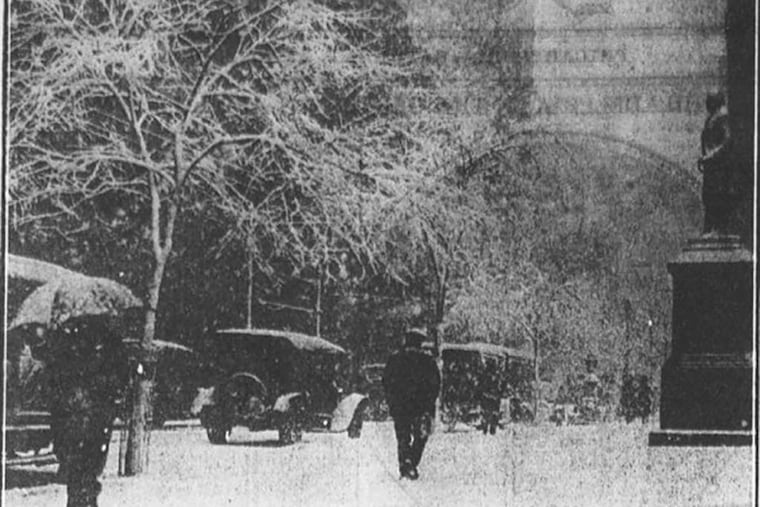Easter whiteout: The improbable blizzard of 1915
The innocuous forecast that appeared on the front page of The Inquirer on April 3, 1915, the Saturday before Easter, did not evoke images of panic in the streets: "Unsettled, rain likely."

The innocuous forecast that appeared on the front page of The Inquirer on April 3, 1915, the Saturday before Easter, did not evoke images of panic in the streets: "Unsettled, rain likely."
What followed, however, was one of the more amazing meteorological events in the history of local weather observations - a 12-hour siege of heavy snow that mocked meteorologists and the powerful April sun by accumulating 19 inches. An additional 0.4 fell on Easter.
"Easter plans blew up with a bang," proclaimed the Evening Bulletin. (For the benefit of our younger readers, updated editions of the newspapers were the 1915 version of online journalism.) "The flakes were sticky and wet and clung heavily to everything they touched."
The storm ripped down power lines and halted horse and motor-vehicle traffic. The Shore was hammered by gusts up to 80 m.p.h.
"Atlantic City Cut Off From World by Storm," read an Inquirer headline.
In all, the ferocious nor'easter that generated the snow was blamed for at least 75 deaths, most of them the result of shipwrecks.
The errant weathermen were unavailable for comment Thursday, although sources indicated that they didn't have 5,000 computer models to consult or StormTracker 6.
Even with a century of advances, snow forecasts are by no means bust-proof, noted Paul J. Kocin, a winter-storm expert and meteorologist with the National Oceanic and Atmospheric Administration.
But "chances are a system like this wouldn't be a total surprise" today.
The storm had wide-ranging impacts from North Carolina to southern New England. Despite the storm and the raging of World War I in Europe, President Woodrow Wilson did get in a round of golf in the snow.
But Washington, with 3.5 inches measured, wasn't hit as hard. Philadelphia, said Kocin, was in the bull's-eye. Newark, N.J., reported 15.8 inches and New York City 10.2.
Remarkably, almost all of Philadelphia's snow fell between 8 a.m. and 8 p.m. on the third, according to The Philadelphia Area Weather Book, by meteorologists Glenn Schwartz of NBC10 and Jon Nese of Pennsylvania State University. The sun didn't set that day until 6:26 p.m., and the temperature never got below 30.
Keep in mind that in those days, snow was measured in the heart of the urban heat island, at 10th and Chestnut Streets.
The snow had to be profoundly heavy, Kocin said, to create an environment cold enough for it to stick.
"The quantity of snow in the air is changing the whole constitution of the air," he said.
According to the Bulletin's account: "Blown in a drifting cloud by the wind, the snow piled in heaps, blew in the faces of pedestrians and made walking a decidedly unpleasant, not to say hazardous, feat."
Nor was the snow a gentleman.
"Women compelled to be out were [an] especially bad case," the Bulletin said, "as their skirts offered more resistance to the wind."
Winds of up to 40 m.p.h. were reported in the city.
Forty horse-drawn and three "motor propelled" plows and 3,000 workers were deployed to fight the snow in Center City. If they could have waited a day, the removal process would have been a breeze.
On Easter, the April sun, evidently smarting from the wintry insult, made quick work of the snow. By 8 p.m., only 2.5 inches remained at 10th and Chestnut.
The world rejoined Atlantic City, which was able to clear the Boardwalk sufficiently to host the annual Easter Parade. In the words of one headline: "Spring fashions attractive in winter setting."
The world has become subtly warmer since that Easter, and Kocin is among the scientists who believe it is having an impact on storm activity. The 1915 storm, however, shows that extreme weather is nothing new, and Kocin added that it is perilous to draw conclusions about climate from any one storm.
Said Kocin, "These are all individual events."
BY THE NUMBERS
19.4
inches of snow fell on April 3-4, 1915.
80
m.p.h. wind gusts were reported in Atlantic City.
46
m.p.h. wind gusts were reported in Philadelphia.
3,000
workers cleared snow in Center City.
EndText
610-313-8210 @woodt15